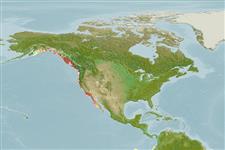Common names from other countries
Classification / Names / Names
Common names | Synonyms | Catalog of Fishes (gen., sp.) | ITIS | CoL | WoRMS
Environment: milieu / climate zone / depth range / distribution range
Ecology
Benthic; depth range 0 - 80 m (Ref. 865). Temperate
Eastern Pacific: Alaska to Mexico.
Length at first maturity / Size / Weight / Age
Maturity: Lm ? range ? - ? cm Max length : 7.5 cm SHD male/unsexed; (Ref. 95344)
Found on rocks along open coasts in shallow subtidal areas to depths of 61 m. Shell may be covered with coralline algae (Ref. 95344).
Life cycle and mating behavior
Maturity | Reproduction | Spawning | Eggs | Fecundity | Larvae
Members of the order Patellogastropoda are mostly gonochoric and broadcast spawners. Life cycle: Embryos develop into planktonic trocophore larvae and later into juvenile veligers before becoming fully grown adults.
Marliave, J.B., C.J. Gibbs, D.M. Gibbs, A.O. Lamb and S.J.F. Young. 2011. (Ref. 93916)
IUCN Red List Status (Ref. 130435)
CITES status (Ref. 108899)
Not Evaluated
Not Evaluated
Human uses
| FishSource |
Tools
More information
Age/Size
Growth
Length-weight
Length-length
Morphology
Larvae
Abundance
Internet sources
Estimates based on models
Preferred temperature
(Ref.
115969): 7.6 - 17.7, mean 9.6 (based on 72 cells).
Price category
Unknown.
